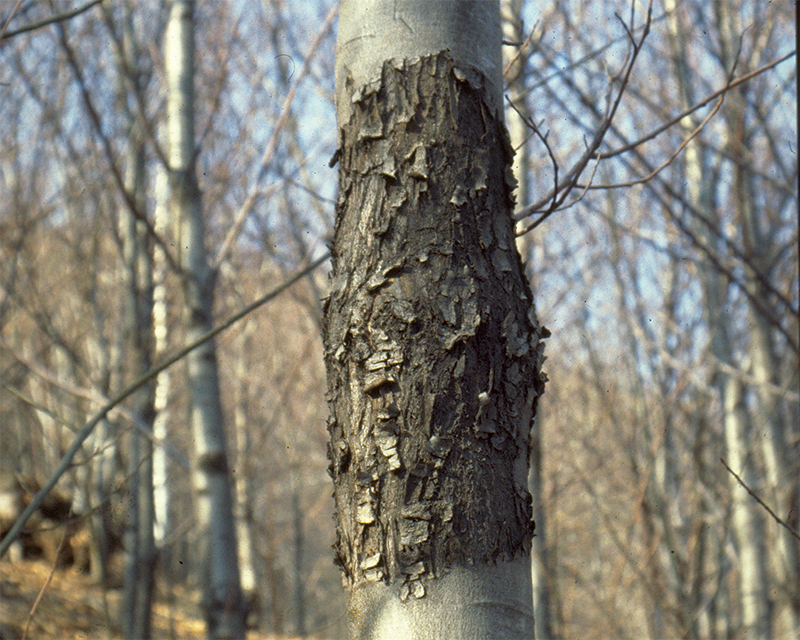Chestnut blight (Cryphonectria parasitica) is a fungal disease originating from Asia which affects sweet chestnut trees. Since 1948, in spite of extreme precautions, the disease has spread rapidly from Italy into the whole of the Canton Ticino. The fungus attacks the bark of the trunks and branches and interrupts the water-nutrient uptake. Above the site of infection the trees wilt.
At the beginning of the epidemic in the Ticino the crowns of many dead sweet chestnut trees were visible. However, since the end of the 1950’s the cankers have healed and tree mortality has decreased. The reason for this is a virus, the so called Cryphonectria-hypovirus which attacks and weakens the pathogens of the chestnut blight fungus so that it no longer presents a danger to sweet chestnut trees.
On the northern side of the Alps the chestnut blight was first observed in 1986 in Monthey/VS. A short time later it was to be found in many other sweet chestnut stands in the Chablais region, as well as in central and eastern Switzerland. The last report came in 2005 from the area around Morges.
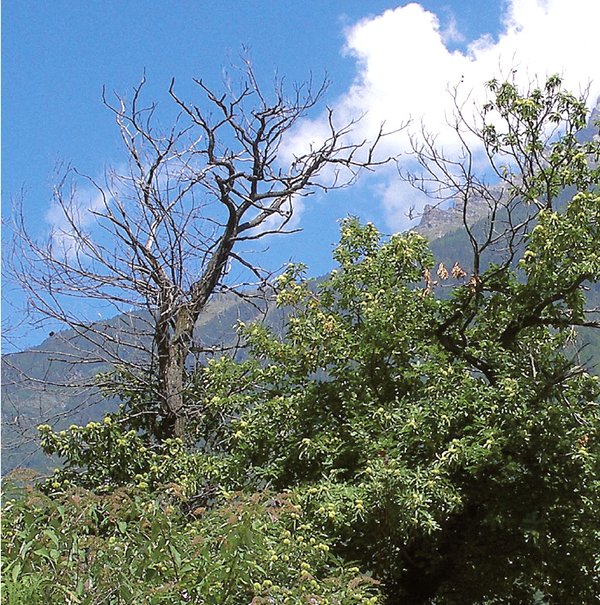
Fig. 1 - Sweet chestnut stand Collonges, Camping "La Châtaigneraie" 2005. Photo: Phytopathology WSL
Phytosanitary and biological measures
As soon as the chestnut blight was detected the local forest services tried to wipe out the disease north of the Alps; they cut off diseased branches or even felled whole trees and burnt the infested bark. The tree stumps were covered with earth to prevent reshooting in the hope that the pathogens would not be able to survive and to delay a new outbreak of the disease. In the majority of stands however the disease was already well advanced and it was not possible to wipe it out.
Apart from phytosanitary measures it is also possible to fight the fungal infestation biologically with the hypovirus from the Ticino. Chestnut cankers which were treated with the hypovirus stopped growing and started to heal. In France sweet chestnuts in fruit plantations are being successfully treated in such a way. The hypovirus is only transferred between Cryphonectriaparasitica strains which are compatible with each other. Therefore before each treatment it must be determined which compatible types are present in a stand. The treatment is best carried out with a local C. parasitica strain, which has been infected with the hypovirus in the laboratory.
Treatment of the chestnut blightThe treatment involves five steps:
The isolation of the fungus, its analysis and the culture of the hypovirulent fungal slurry are carried out by the WSL (Daniel Rigling, see below). The actual treatment of the cankers is easy and can be carried out by the forest service. |
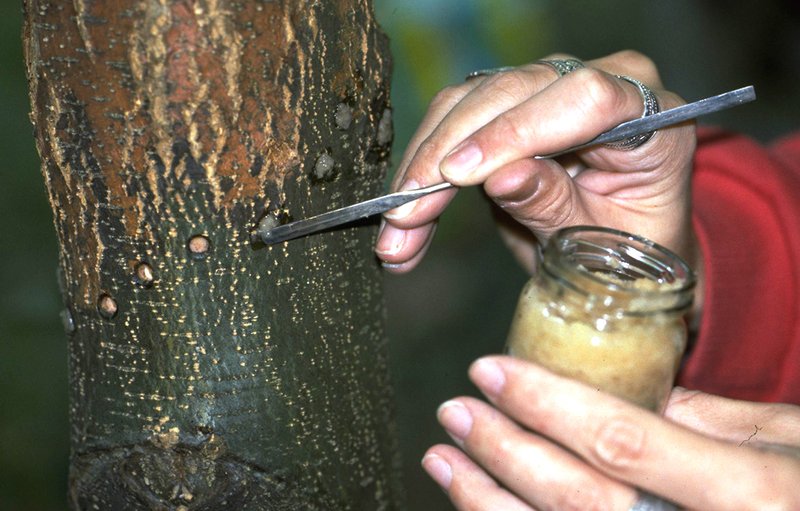
Fig. 2 - Holes are bored around the cankers with a cork drill. These are filled with fungal slurry which contains the hypovirus. Photo: Phytopathology WSL
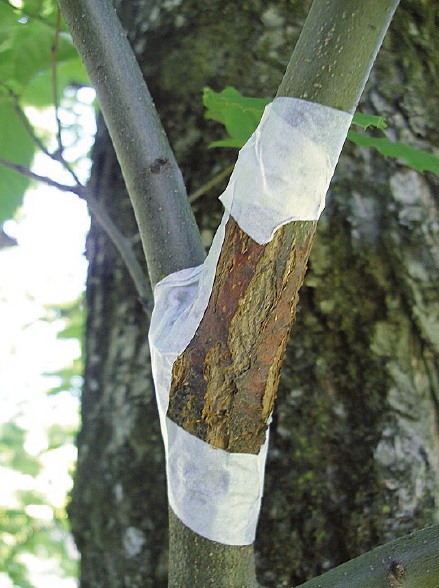
Fig. 3 - To prevent drying out, the holes are sealed with adhesive tape. Photo: Phytopathology WSL
In the past few years new interest has been aroused in the sweet chestnut tree. Projects to conserve or re-establisch chestnut forests have been started in various locations in central Switzerland, near Murg (Lake Walen) and in the Chablais region where high forests und coppices were thinned. In the course of these proceedings the forest service discovered chestnut blight in many places. In some sweet chestnut stands it was very proliferent. The use of phytosanitary measures alone could not control the disease. Therefore, the WSL together with the forest services of the cantons Lucerne, St. Gallen, Vaud, Valais and Zug worked out a project for hypovirulence treatment of chestnut blight north of the Alps.
The WSL phytopatholgy group charted the cankers, isolated C. parasitica, analysed its compatibility type in the laboratory and subsequently prepared the suitable hypovirulent fungal slurry. In the five cantons between the years 2003 and 2005 they treated a total of 573 cases of bark cankers with the hypovirus.
Success of treatment
After treatment with the hypovirus the cankers mainly stopped growing and the reddish edges of the cankers healed (Fig. 4). 70 % of the chestnut cankers in the Camping of Collonges were considered active before the treatment, that is to say the bark at the edge of the cankers was red and sunken in indicating a strong fungal growth. After treatment with the hypovirus in 2004 only 6 % were classed as active and in 2005 none at all (Fig. 5).
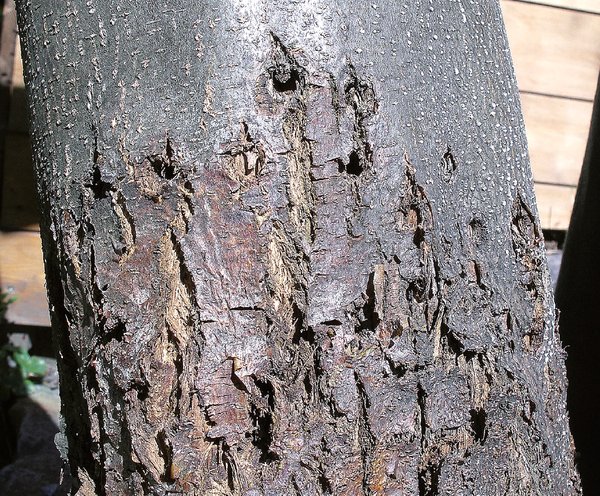
Fig. 4 - Chestnut blight in Collonges, Camping "La Châtaigneraie", one year after treatment with the hypovirus. The treatment holes are still visible. The cankers have not grown any more, their edges are no longer reddish and they are healing.
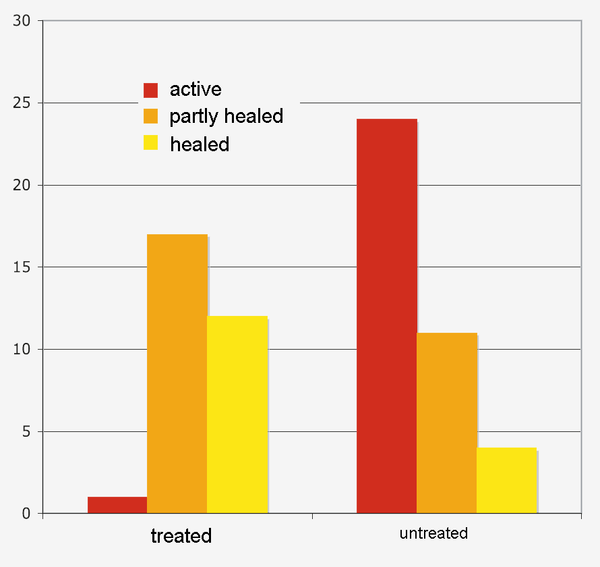
Fig. 5 - Chestnut blight in Collonges, Camping "La Châtaigneraie" in 2005: While most of the treated bark crabs healed, the majority of the untreated crabs were active.
And what now?
The chestnut blight must not be carried into healthy stands. It is an aggressive bark disease, which is endangering the development of sweet chestnut stands and which can hardly be eliminated. It is especially important to import grafted trees from Cryphonectria free regions only (plant passport), because grafts are very susceptible to the disease. It can even break out one to two years after grafting.
Through constant observation of sweet chestnut stands new sources of disease can be recognised early. New sources of infection must be reported to the authorities: Swiss Forest Protection
Phytosanitary measures must be taken quickly. If chestnut blight is found in a stand then it must be eliminated as quickly as possible: infected parts must be cut off and the bark burnt then and there. Infected wood can not be temporarily stored, because the small orange fruit bodies develop very quickly on stored wood.
When re-establishing forests and tending sweet chestnut stands intervention should be restrained. If the pathogen of the sweet chestnut blight is in the area the danger of infection could increase during tending because there could be damage to the bark providing an entrance site for the disease. In open stands the wind can spread existing spores more easily.
The introduction of new strains of C.parasitica must be avoided, because the hypovirus can then no longer spread. Only hypovirus compounds which have been checked by the WSL should be used for biological control.
Treatment with the hypovirus must be intensive and carried out repeatedly. This is however very time consuming with large forest trees. Mainly only branches and coppice shoots are treated. Up to present there is no available method for a widespread application.
Translation: Dawn Meister, Stallikon

